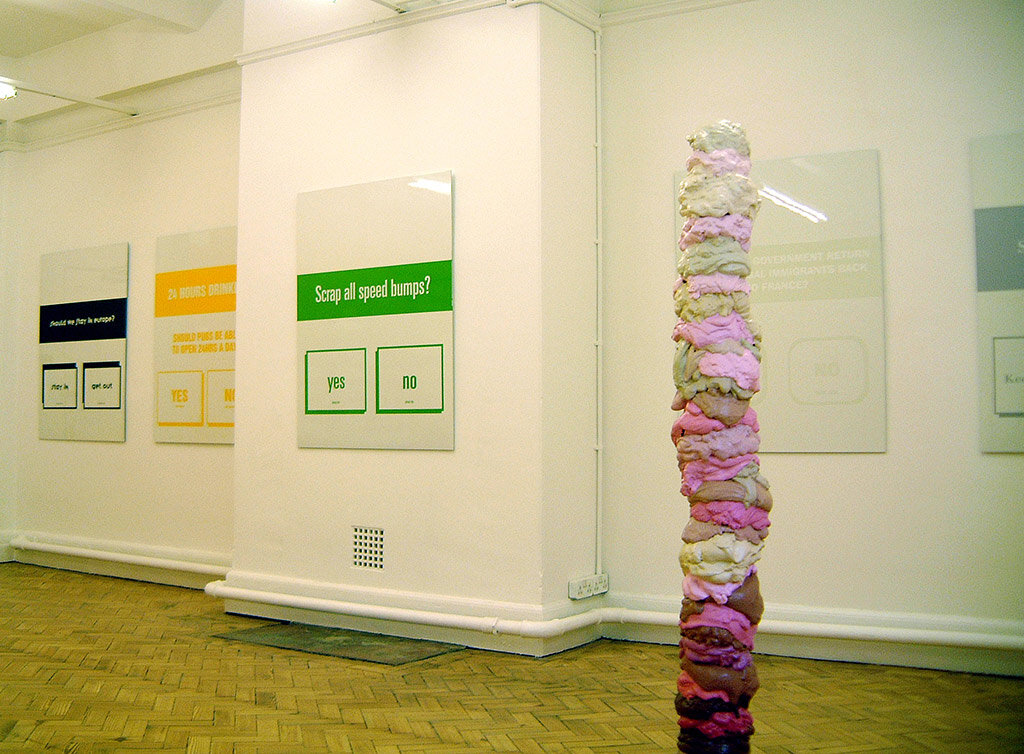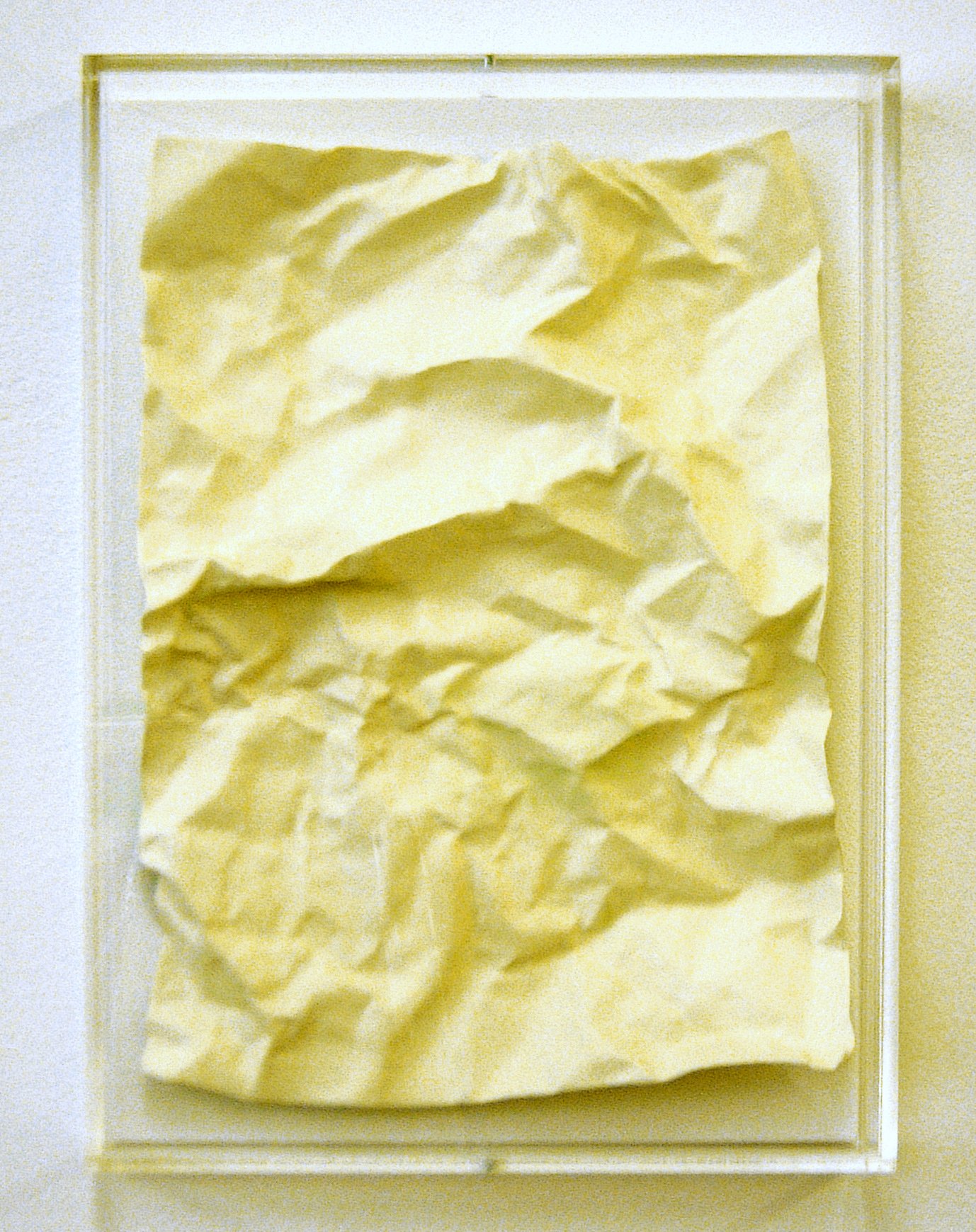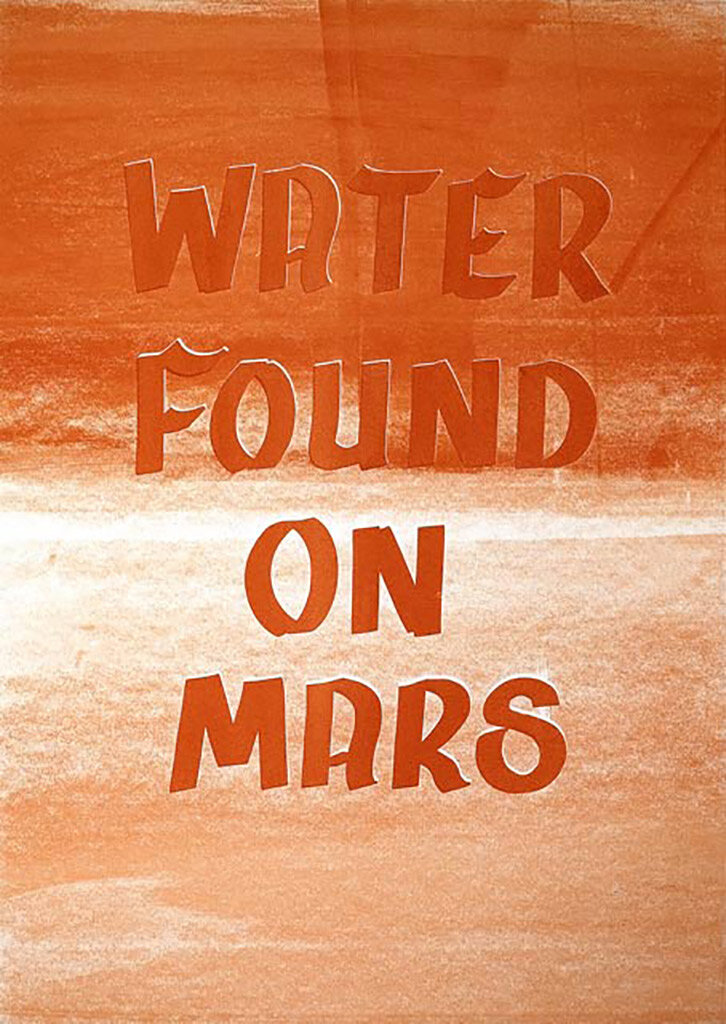Yes No
Richard Forster, Eva Weinmayr
16 July – 13 August 2005
Eva Weinmayr, 31 mph a crime?, from the ‘Today’s Question’ series (detail), 2002, enamel on aluminium, 125x94cm
Eva Weinmayr, Water found on Mars, 2004-05, screenprint, copper pigment on paper, 62x45cm
‘Yes No’ brings together two artists who both take elements of the mundane and everyday life and transform them through their different working processes. Adding to or subtracting from layers of materials or meaning, they share an interest in unsettling visual narratives and confounding initial readings. Stylistic trademarks of formalism are modified, ‘the original’ and ‘the pure’ stripped of easily read meanings.
Richard Forster’s Optimism and Future series started in 2003. It grew from an interest in exploring ways of incorporating ideas of the figurative into an abstract vocabulary of surfaces and forms. Executed in cardboard coated with resin, rubber or steel, each work in the series mimics the appearance of a flat sheet that has been tightly scrunched in on itself then re-flattened to a semi-crumpled state. However, on closer inspection the manufactured nature and skewed geometry of each piece becomes apparent. For ‘Yes No’ Forster is showing three pieces from his Love series (2004-05), each the standard A4 paper size. For these, Forster has introduced a new element by foregrounding two triangles in each that sit on the surface. These triangles become ‘characters’, ones that change position from one work to another. This further slippage thus introduces a narrative as well as referencing the figurative tradition in painting and, more particularly, sculpture, with their creamy white surfaces resonant of the marble of classical statues.
Allusions to the human figure and historical traditions in Western art are further explored in Forster’s Stack (2005). Piled one on top of the other, blobs of resin (leftovers from a previous job of art), each coloured with varying hues that echo bodily parts and products, have grown to around average human height. The piece references and contrasts a previous work by Forster, Ten Per Cent Contingency (2000), a blood-red pool on the floor with a rectangular void at its centre as if the residue of some since-departed monochrome canvas. Stack, however, appears more constructive, its orientation and height drawing alluding to the humanistic tradition in Western art. The work inhabits a position where it references – but cannot be straightforwardly classified as – other objects in the world, but ultimately exists as purely itself.
Eva Weinmayr’s Today’s Question series (2002) has its origin in junk faxes sent repeatedly to the artist’s home. The company sending the faxes claims that the replies gathered are presented to politicians and institutions in order to influence their decision-making. However people faxing back the poll slips with a ‘yes’ or ‘no’ box ticked are charged a premium fee for doing so. In order to obtain the maximum response – and therefore money – the questions touch on particularly emotive subjects. For a few seconds the recipients gain the power to decide whether to ‘kill’, or ‘stay in’, ‘get out’, etc. but ultimately anyone replying is being taken for a ride. Weinmayr selects the main parts of the poll slips, proceeding to alter the dimensions, colours and overall layout. Using a high tech car paint finish for the resulting works has the dual effect of unifying the disparate questions – the physical technique glossing over the emotional content – whilst simultaneously acting as a prompt to greater consideration of the complexity of what is being asked.
Richard Forster, Stack (detail), 2005, resin, paint, 162x16cm. Photo: Colin Davison
Richard Forster, Stack, 2005, resin, paint, 162x16cm. Photo: Colin Davison
Richard Forster, Stack, 2005, resin, paint, 162x16cm. Photo: Colin Davison
Richard Forster, Stack (detail), 2005, resin, paint, 162x16cm. Photo: Colin Davison
Water found on Mars (2004-05) is a wall installation of monoprints based on a poster from the London Evening Standard newspaper stands. It is part of an ongoing project by Weinmayr, who has gathered a large collection of the daily papers’ ‘teaser bills’. It examines how complex realities are shrunk into sound bites, in this case a series of two-, three- or four-line banner headlines. In and of themselves, these originally black and white headlines give no information; rather they are teasers with no context. Through reproducing these headlines – and repeating the same one in a number of monoprints – Weinmayr emphasises the gap between the actual and the imagined.
Take a video tour of the exhibition
Share this page


















